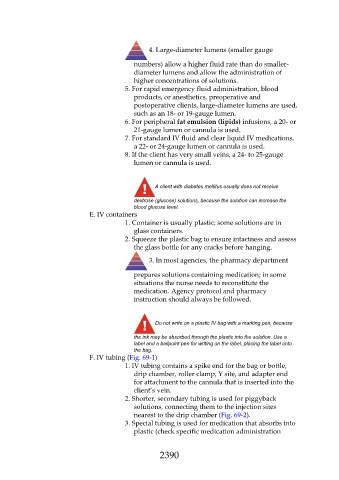Page 2390 - Saunders Comprehensive Review For NCLEX-RN
P. 2390
4. Large-diameter lumens (smaller gauge
numbers) allow a higher fluid rate than do smaller-
diameter lumens and allow the administration of
higher concentrations of solutions.
5. For rapid emergency fluid administration, blood
products, or anesthetics, preoperative and
postoperative clients, large-diameter lumens are used,
such as an 18- or 19-gauge lumen.
6. For peripheral fat emulsion (lipids) infusions, a 20- or
21-gauge lumen or cannula is used.
7. For standard IV fluid and clear liquid IV medications,
a 22- or 24-gauge lumen or cannula is used.
8. If the client has very small veins, a 24- to 25-gauge
lumen or cannula is used.
A client with diabetes mellitus usually does not receive
dextrose (glucose) solutions, because the solution can increase the
blood glucose level.
E. IV containers
1. Container is usually plastic; some solutions are in
glass containers.
2. Squeeze the plastic bag to ensure intactness and assess
the glass bottle for any cracks before hanging.
3. In most agencies, the pharmacy department
prepares solutions containing medication; in some
situations the nurse needs to reconstitute the
medication. Agency protocol and pharmacy
instruction should always be followed.
Do not write on a plastic IV bag with a marking pen, because
the ink may be absorbed through the plastic into the solution. Use a
label and a ballpoint pen for writing on the label, placing the label onto
the bag.
F. IV tubing (Fig. 69-1)
1. IV tubing contains a spike end for the bag or bottle,
drip chamber, roller clamp, Y site, and adapter end
for attachment to the cannula that is inserted into the
client’s vein.
2. Shorter, secondary tubing is used for piggyback
solutions, connecting them to the injection sites
nearest to the drip chamber (Fig. 69-2).
3. Special tubing is used for medication that absorbs into
plastic (check specific medication administration
2390

